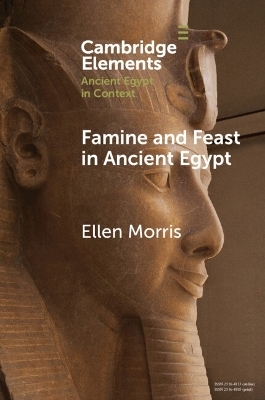
Famine and Feast in Ancient Egypt
Seiten
2023
Cambridge University Press (Verlag)
978-1-009-07458-2 (ISBN)
Cambridge University Press (Verlag)
978-1-009-07458-2 (ISBN)
Severe famine entered ancient Egyptian collective memory via personal reflection, literature, prophecy, and, most effectively, a ludic 'festival of remembrance.' This Element is about the creation and curation of social memory in pharaonic and Greco-Roman Egypt.
This Element is about the creation and curation of social memory in pharaonic and Greco-Roman Egypt. Ancient, Classical, Medieval, and Ottoman sources attest to the horror that characterized catastrophic famines. Occurring infrequently and rarely reaching the canonical seven-years' length, famines appeared and disappeared like nightmares. Communities that remain aware of potentially recurring tragedies are often advantaged in their efforts to avert or ameliorate worst-case scenarios. For this and other reasons, pharaonic and Greco-Roman Egyptians preserved intergenerational memories of hunger and suffering. This Element begins with a consideration of the trajectories typical of severe Nilotic famines and the concept of social memory. It then argues that personal reflection and literature, prophecy, and an annual festival of remembrance functioned-at different times, and with varying degrees of success-to convince the well-fed that famines had the power to unseat established order and to render a comfortably familiar world unrecognizable.
This Element is about the creation and curation of social memory in pharaonic and Greco-Roman Egypt. Ancient, Classical, Medieval, and Ottoman sources attest to the horror that characterized catastrophic famines. Occurring infrequently and rarely reaching the canonical seven-years' length, famines appeared and disappeared like nightmares. Communities that remain aware of potentially recurring tragedies are often advantaged in their efforts to avert or ameliorate worst-case scenarios. For this and other reasons, pharaonic and Greco-Roman Egyptians preserved intergenerational memories of hunger and suffering. This Element begins with a consideration of the trajectories typical of severe Nilotic famines and the concept of social memory. It then argues that personal reflection and literature, prophecy, and an annual festival of remembrance functioned-at different times, and with varying degrees of success-to convince the well-fed that famines had the power to unseat established order and to render a comfortably familiar world unrecognizable.
1. Famine and Social Memory; 2. The Role of Witness Literature in Preserving Social Memory; 3. The Role of 'Prophecy' in Preserving Social Memory; 4. The Role of Rituals in Preserving Social Memory; References.
| Erscheinungsdatum | 27.06.2023 |
|---|---|
| Reihe/Serie | Elements in Ancient Egypt in Context |
| Zusatzinfo | Worked examples or Exercises |
| Verlagsort | Cambridge |
| Sprache | englisch |
| Maße | 152 x 229 mm |
| Gewicht | 149 g |
| Themenwelt | Geisteswissenschaften ► Archäologie |
| Geschichte ► Allgemeine Geschichte ► Vor- und Frühgeschichte | |
| Geschichte ► Allgemeine Geschichte ► Altertum / Antike | |
| Geisteswissenschaften ► Geschichte ► Regional- / Ländergeschichte | |
| Geschichte ► Teilgebiete der Geschichte ► Kulturgeschichte | |
| Geisteswissenschaften ► Religion / Theologie ► Weitere Religionen | |
| ISBN-10 | 1-009-07458-X / 100907458X |
| ISBN-13 | 978-1-009-07458-2 / 9781009074582 |
| Zustand | Neuware |
| Haben Sie eine Frage zum Produkt? |
Mehr entdecken
aus dem Bereich
aus dem Bereich
auf den Spuren der frühen Zivilisationen
Buch | Hardcover (2023)
C.H.Beck (Verlag)
CHF 27,95
Konzepte – Methoden – Theorien
Buch | Softcover (2024)
UTB (Verlag)
CHF 55,85
Was Pompeji über uns erzählt
Buch | Hardcover (2023)
Propyläen (Verlag)
CHF 44,75


